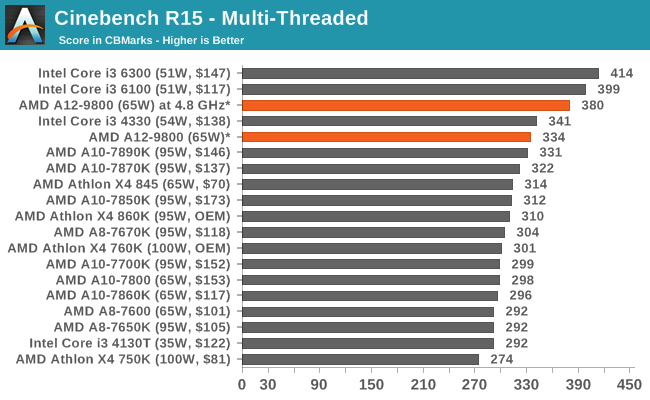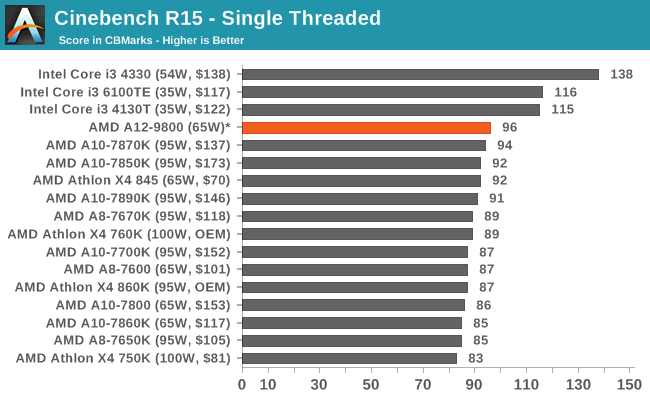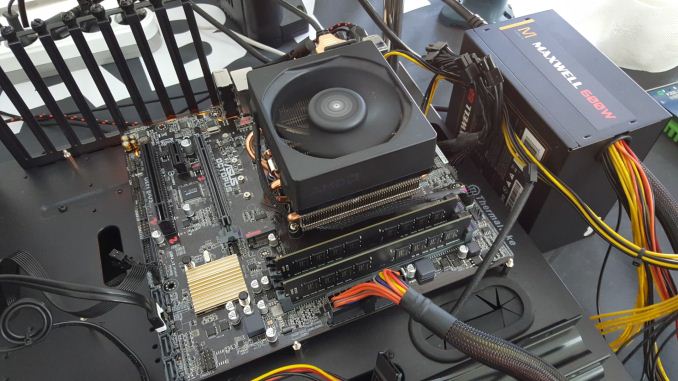AMD 7th Gen Bristol Ridge and AM4 Analysis: Up to A12-9800, B350/A320 Chipset, OEMs first, PIBs Later
by Ian Cutress on September 23, 2016 9:00 AM EST
Over the last two weeks, AMD officially launched their 7th Generation Bristol Ridge processors as well as the new AM4 socket and related chipsets. The launch was somewhat muted, as the target for the initial launch is purely to the big system OEMs and system integrators, such as Lenovo, HP, Dell and others – for users wanting to build their own systems, ‘Product-in-Box’ units (called PIBs) for self-build systems will come at the end of the year. We held off on the announcement because the launch and briefings left a number of questions unanswered as to the potential matrix of configurations, specifications of the hardware and how it all connects together. We got a number of answers, so let’s delve in.
The CPUs
The seven APUs and one CPU being launched for OEM systems spans from a high-frequency A12 part using the 7th Generation microarchitecture (we call it Excavator v2) to the A6, and they all build on the Bristol Ridge notebook parts that were launched earlier in the year but focused on the desktop this time around. AMD essentially skipped the 6th Gen, Carrizo, for desktop as the design was significantly mobile focused – we ended up with one CPU, the Athlon X4 845 (which we reviewed), with DDR3 support but no integrated graphics. Using the updated 28nm process from TSMC, AMD was able to tweak the microarchitecture and allow full on APUs for desktops using a similar design.
The full list of processors is as follows:
| AMD 7th Generation Bristol Ridge Processors | |||||
| Modules/ Threads |
CPU Base / Turbo (MHz) |
GPU | GPU Base / Turbo (MHz) |
TDP | |
| A12-9800 | 2M / 4T | 3800 / 4200 | Radeon R7 | 800 / 1108 | 65W |
| A12-9800E | 2M / 4T | 3100 / 3800 | Radeon R7 | 655 / 900 | 35W |
| A10-9700 | 2M / 4T | 3500 / 3800 | Radeon R7 | 720 / 1029 | 65W |
| A10-9700E | 2M / 4T | 3000 / 3500 | Radeon R7 | 600 / 847 | 35W |
| A8-9600 | 2M / 4T | 3100 / 3400 | Radeon R7 | 655 / 900 | 65W |
| A6-9500 | 1M / 2T | 3500 / 3800 | Radeon R5 | 720 / 1029 | 65W |
| A6-9500E | 1M / 2T | 3000 / 3400 | Radeon R5 | 576 / 800 | 35W |
| Athlon X4 950 | 2M / 4T | 3500 / 3800 | - | - | 65W |
AMD’s mainstream processors will now hit a maximum of 65W in their official thermal design power (TDP), with the launch offering a number of 65W and 35W parts. There is the potential to offer CPUs with a configurable TDP, however much like the older parts that supported 65W/45W modes, it was seldom used, and chances are we will see OEMs stick with the default design power windows here. Also, the naming scheme: any 35W part now has an ‘E’ at the end of the processor name, allowing for easier identification.
As part of this review, we were able to snag a few extra configuration specifications for each of the processors, including the number of streaming processors in each, base GPU frequencies, base Northbridge frequencies (more on the NB later), and confirmation that all the APUs launched will support DDR4-2400 at JEDEC sub-timings.
| AMD 7th Generation 65W Bristol Ridge Processors | |||||
| Modules/ Threads |
CPU Base / Turbo (MHz) |
GPU SPs |
GPU Base / Turbo (MHz) |
Northbridge Base (MHz) |
|
| A12-9800 | 2M / 4T | 3800 / 4200 | 512 | 800 / 1108 | 1400 |
| A10-9700 | 2M / 4T | 3500 / 3800 | 384 | 720 / 1029 | 1400 |
| A8-9600 | 2M / 4T | 3100 / 3400 | 384 | 655 / 900 | 1300 |
| A6-9500 | 1M / 2T | 3500 / 3800 | 384 | 720 / 1029 | 1400 |
| Athlon X4 950 | 2M / 4T | 3500 / 3800 | - | - | 1400 |
| AMD 7th Generation 35W Bristol Ridge Processors | |||||
| Modules/ Threads |
CPU Base / Turbo (MHz) |
GPU SPs |
GPU Base / Turbo (MHz) |
Northbridge Base (MHz) |
|
| A12-9800E | 2M / 4T | 3100 / 3800 | 512 | 655 / 900 | 1300 |
| A10-9700E | 2M / 4T | 3000 / 3500 | 384 | 600 / 847 | 1300 |
| A6-9500E | 1M / 2T | 3000 / 3400 | 256 | 576 / 800 | 1300 |
The A12-9800 at the top of the stack is an interesting part on paper. If we do a direct comparison with the previous high-end AMD APUs, the A10-7890K, A10-7870K and A10-7860K, a lot of positives end up on the side of the A12.
| High-End AMD APU Comparison | |||||||
| A12-9800 | A10-7890K | A10-7870K | A10-7860K | A10-9700 | |||
| MSRP | - | $165 | $137 | $117 | - | ||
| Platform | Bristol Ridge | Kaveri Refresh | Bristol Ridge | ||||
| uArch | Excavator v2 | Steamroller | Steamroller | Steamroller | Excavator v2 | ||
| Threads | 2M / 4T | 2M / 4T | 2M / 4T | 2M / 4T | 2M / 4T | ||
| CPU Base Freq | 3800 | 4100 | 3900 | 3600 | 3500 | ||
| CPU Turbo Freq | 4200 | 4300 | 4100 | 4000 | 3800 | ||
| IGP SPs | 512 | 512 | 512 | 512 | 384 | ||
| GPU Turbo Freq | 1108 | 866 | 866 | 757 | 1029 | ||
| TDP | 65W | 95W | 95W | 65W | 65W | ||
| L1-I Cache | 192 KB | 192 KB | 192 KB | 192 KB | 192 KB | ||
| L1-D Cache | 128 KB | 64 KB | 64 KB | 64 KB | 128 KB | ||
| L2 Cache | 2 MB | 4 MB | 4 MB | 4 MB | 2 MB | ||
| DDR Support | DDR4-2400 | DDR3-2133 | DDR3-2133 | DDR3-2133 | DDR4-2400 | ||
| PCIe 3.0 | x8 | x16 | x16 | x16 | x8 | ||
| Chipsets | B350 A320 X/B/A300 |
A88X A78 A68H |
A88X A78 A68H |
A88X A78 A68H |
B350 A320 X/B/A300 |
||
The frequency of the A12-9800 gives it a greater dynamic range than the A10-7870K (having 3.8-4.2 GHz, rather than 3.9-4.1), but with the newer Excavator v2 microarchitecture, improved L1 cache, AVX 2.0 support and a much higher integrated graphics frequency (1108 MHz vs. 866 MHz) while also coming in at 30W less TDP. The 30W TDP jump is the most surprising – we’re essentially getting better than the previous A10-class performance at a lower power, which is most likely why they started naming the best APU in the stack an ‘A12’. Basically, the A12-9800 APU will be an extremely interesting one to review given the smaller L2 cache but faster graphics and DDR4 memory.
A Wild Overclocker Appears!
Given that technically the systems with the new APUs have been released for a couple of weeks, some vendors have their internal enthusiasts play around with the platform. Bearing in mind that AMD has not announced any formal overclocking support on these new APUs, NAMEGT, a South Korean overclocker with ties to ASUS, has pushed the A12-9800 APU to 4.8 GHz by adjusting the multiplier. To do this, he used an unreleased ASUS Octopus AM4 motherboard and AMD’s 125W Wraith air cooler (which will presumably be bundled with PIBs later in the product cycle).
NAMEGT ran this setup on multithreaded Cinebench 11.5 and Cinebench 15, scoring 4.77 and 380 respectively for a 4.8 GHz overclock. If we compare this to our Bench database results, we see the following

For Cinebench 15, this overclocked score puts the A12-9800 above the Haswell Core i3-4360 and the older AMD FX-4350, but below the newer Skylake i3-6100TE. The Athlon X4 845 at stock frequencies scored 314 while running at 3.5 GHz, which would suggest that a stock A12-9800 at 3.8 GHz would fall around the 340 mark.

(Since writing this, a preview by Korean website Bodnara, using the A12-9800 in a GIGABYTE motherboard, scored 334 for a stock Cinebench 15 multithreaded test and 96 for the single threaded test. We've added this result for perspective.)

When we previously tested the Excavator architecture for desktop on the 65W Athlon X4 845, overclocking was a nightmare, with stability being a large issue. At the time, we suspected that due to the core design being focused towards 15W, moving beyond 65W was perhaps a bit of a stretch for the design at hand. This time around, as we reported before, Bristol Ridge is using an updated 28nm process over Carrizo, which may have a hand in this.
When we asked AMD about overclocking details on the new APUs, the return reply was along the lines of ‘No OEM systems at this time will be unlocked, and no official comment on the individual units. More details will be released closer to the platform launch for DIY users’.












122 Comments
View All Comments
gregounech - Friday, September 23, 2016 - link
I want to see an AMD A10 vs Apple A10 article.goatfajitas - Friday, September 23, 2016 - link
Why? AMD is an x86 processors that can run Windows and complete systems. Apple is an ARM processor that runs nice toys. They are not in the same ballpark.KPOM - Friday, September 23, 2016 - link
Universal Windows apps can run on ARM.wumpus - Friday, September 23, 2016 - link
All three of them, but don't expect even them to work until tested.Michael Bay - Saturday, September 24, 2016 - link
Update your mantra, it smells.goatfajitas - Friday, September 23, 2016 - link
OK, but that isnt really the point. Comparing ARM to x86 is like comparing a sports car to an 18 wheel truck. Both are good, both have their purpose, but they aren't really in the same market segments. Are is great at specific things, where x86 is the workhorse of the industry.ddriver - Friday, September 23, 2016 - link
Generalizing like that is quite foolish, atom is x86, but it is closer to a wheelchair than an 18 wheeler.From what I can tell, the apple's A10 is about the same performance as premium mobile device x86 chips from intel. The fact that it has no serious programs for it and doesn't allow you to run even your own programs without jailbreaking ... is a whole different topic.
Performance is one metric, usability - another metric. And sure, performance without usability is a shame, but that's what the corporations dictate - those aren't devices for you to use as much as they are devices for you to be used.
bji - Friday, September 23, 2016 - link
Do you think anyone actually cares about your sense of superiority over mobile app users?ddriver - Friday, September 23, 2016 - link
I don't care what anyone cares about, their biz, not mine.Samus - Saturday, September 24, 2016 - link
Using that ideology let's just say many people don't like your strong opinions projected upon them, either.